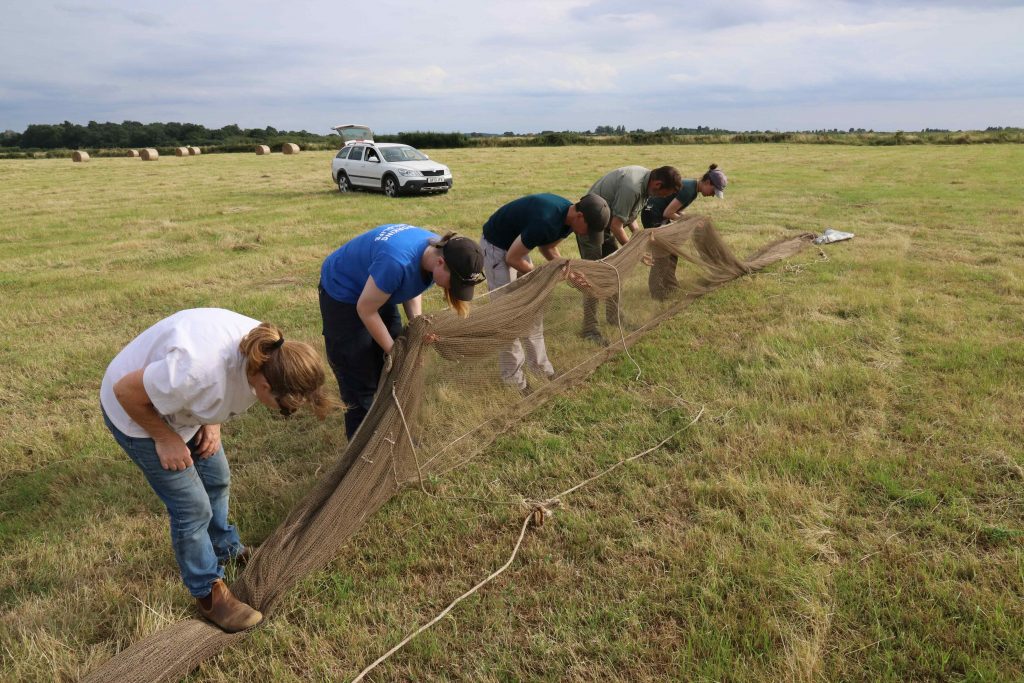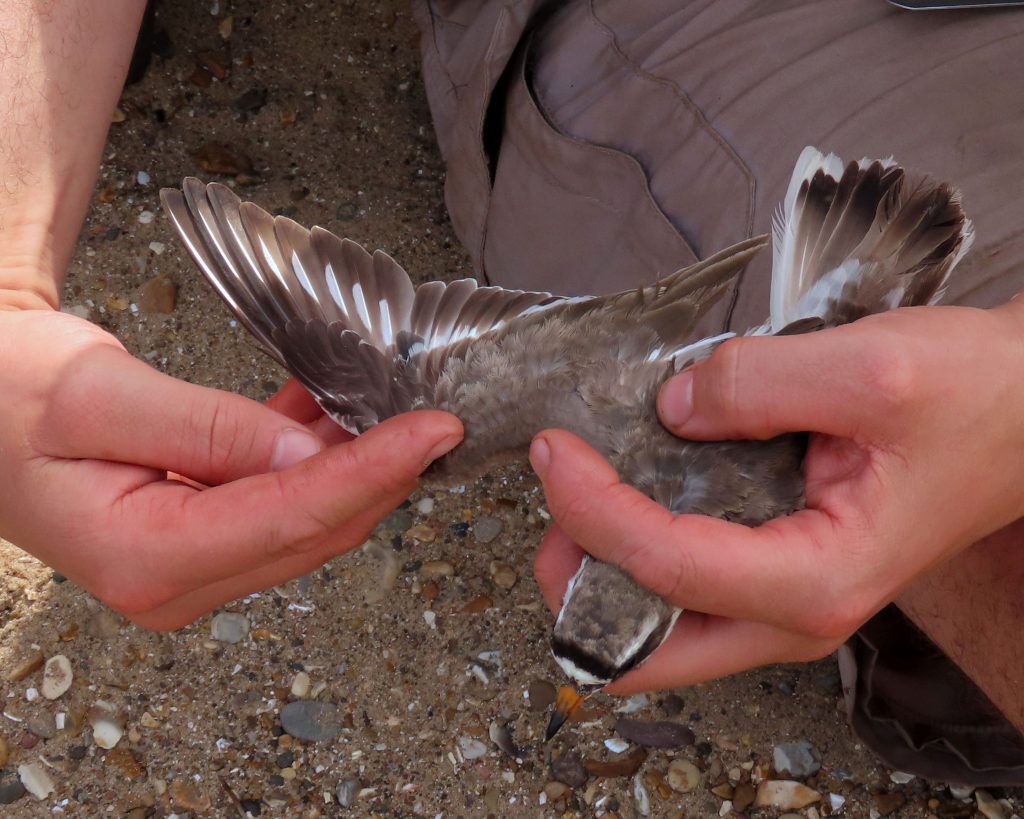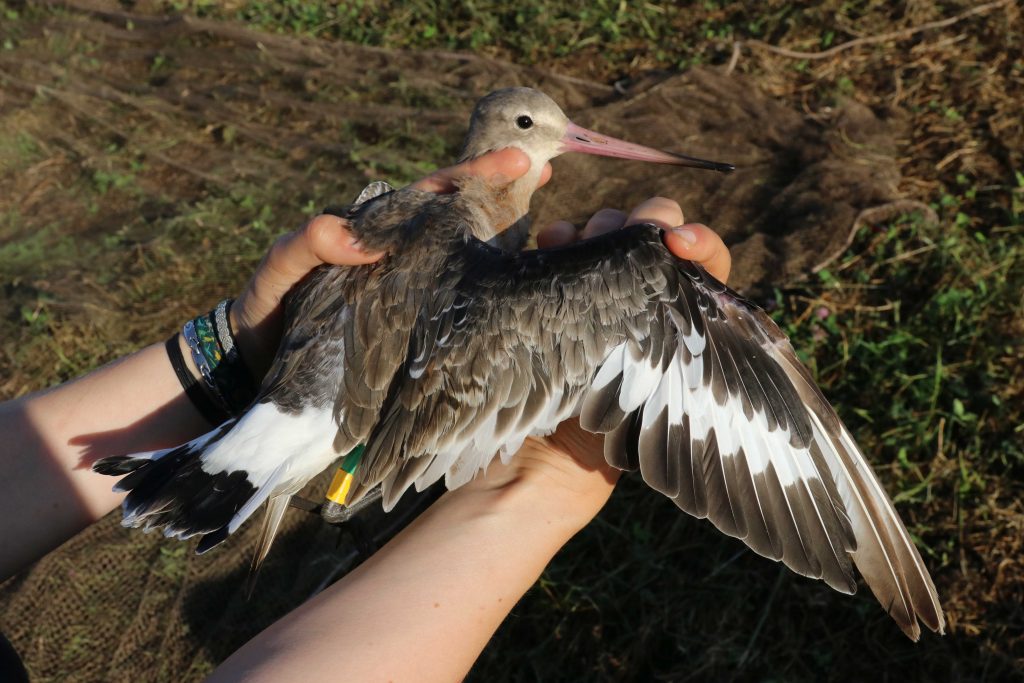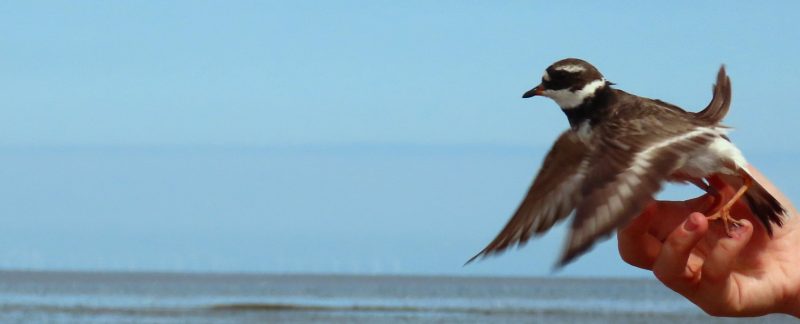Thursday 1 August
Lou, Gary and Jean recced on Thursday morning, getting up at 05:00, leaving at 05:30 and arriving at Heacham North North at 06:10. They found 40 Turnstone spread out along with a few Sanderling and saw 800 Oystercatcher on the bend on Heacham South which were tightly clustered until 08:10.
Not much was present on Snettisham beach. Some of the fields behind the sea wall had been cut for hay and baled. The field between the two sea walls had 50 Curlew in, at least five of which had colour rings on. At 08:10 there was another 90 Curlew in the field by the road, which then flew and joined the other 50. There were 1,000 Black-tailed Godwit roosting in the newly landscaped field by the RSPB car park at 09:15, with another 1,000 Black-tailed Godwits feeding amongst the cut hay with 20 Curlew in the field next door.
Most of the team went to the Lincolnshire side to catch on the Horseshoe Lagoon at 14:30.
Nigel, Gary and Lou stayed on the Norfolk side and split up to recce the morning’s Curlew, Oystercatcher and godwit sites for evening activity. Nigel, Gary and Lou were joined by Chris and Sophie and set two full large mesh nets on Heacham South for Oystercatcher for a catch on Friday morning. The set went well, finished by 22:30, despite not being able to get through the gate on to Snettisham initially as a wildfowler had changed the padlock whilst he fixed the old one. After a phone call we got the right key.
Friday 2 August
The team got up at 04:45 on Friday morning and headed out to Heacham South. Hannah and Chris were long stops, Nigel, Gary and Lou were in the hide and Guy was in charge of base camp. As soon as we arrived there were 600 Oystercatchers on the beach in three groups, only 10 in front of net 1 and 120 in front of net 2; we waited for the tide to come up. Chris started to twinkle the Oystercatchers from the Heacham side and a catch was taken while the area was still dry.
Heacham Beach totals
| New | Retrap | Total | |
| Oystercatcher | 62 | 28 | 90 |
There was some amusement when Nigel asked Guy to arm the box and was met with a reply of ‘where is it?’ It turned out to still have been in Nigel’s car! It was promptly retrieved and armed.
Nigel left after the catch and recced the godwit field by the RSPB car park.
When returning to the fieldwork base, the teams were stuck in traffic for two hours! After breakfast a briefing and introductions, the cars and trailers were packed and the team went out at 14:00 to set the nets on the field by the RSPB car park. Most of the Lincolnshire team came round to join us, apart from Ryan and Ros who stayed behind to recce on the Lincs side.
Four full-size small-mesh nets were set as a double clap-net pair. The field has been topped so there was plenty of grass to cover the nets and cannons with. Kirsty and Sophie brought a picnic out to the team which was eaten quickly. Hide 1, which was the firing hide, contained Nigel, Jacquie and Guy while Hide 2 (the non-firing hide) contained Gary, Lou and Louise. Some godwits were in the catching area when the teams got into the hide and very quickly, more godwits came in. It was an interesting catch with birds spreading and landing in safety. The jiggler was used extensively on all the nets with the birds reluctant at first, then some tried to eat the jiggler, before finally leaving the safety areas; the far two nets were fired as a clap-net pair. All the known-aged young birds were colour ringed.

Field catch totals
| New | Retrap | Total | |
| Black-tailed Godwit | 103 | – | 103 |
After the birds had been processed, the nets were reset and everyone went back to the Norfolk fieldwork base. At the briefing, it was decided that the Norfolk team would try again to catch on the same field the following day while the Lincolnshire team would set nets on Snettisham Beach for Sanderling (800 had been seen on the recce).
Saturday 3 August
The morning started at 04:00 (for the hide and Lincolnshire teams) and 04:30 for everyone else.
Field team
Hide 1, the firing hide, contained Mark (on the box), Nigel, Guy and Cathy (on the video camera). Hide 2, non-firing hide, contained Gary, Lou and Jen D.
It was very foggy; Gary and Lou could see birds in the catching area straight away because their hide was closer to the nets but the firing hide couldn’t see their side. More birds dropped in and as the fog started to lift, the firing hide team could see that there were Greylag Geese sitting on Nigel’s net! After jiggling they moved over to Gary and Lou’s safety area, saw the net and ran away. The godwits were not fazed and carried on feeding. More came into the flock and it built to 215 birds spread over the two near nets of the clap-net pair. Some godwits were in the safety area of Gary and Lou’s nets and after lots of jiggling they left; one third of the birds walked out of the net towards the hides.
Field catch totals
| New | Retrap | Total | |
| Black-tailed Godwit | 146 | 3 | 149 |
| Starling | 4 | – | 4 |
Again, some of the known-aged young birds were colour ringed. By 10 August, two of these colour-ringed Black-tailed Godwit had been recorded elsewhere – one at Titchwell and one at Holme.
Once they had finished processing, most of the Norfolk team joined the Lincolnshire team on Snettisham Beach and helped process their catch. Some of the Norfolk team stayed behind and reset one of the clap-net pairs and packed away the other equipment with the plan being to have another go in that field on Monday or Tuesday.
Snettisham Beach catch totals
| New | Retrap | Total | |
| Oystercatcher | 5 | – | 5 |
| Ringed Plover | 4 | – | 4 |
| Sanderling | 213 | 21 | 233 |
| Dunlin | 125 | 2 | 127 |
| Total | 349 | 23 | 372 |

The teams returned to the Norfolk fieldwork base for a lovely breakfast made by Hannah and Jean and to plan for the rest of the day. Ros and Ryan had found a field with 350 Curlew, so the Lincolnshire team headed back to Lincs after breakfast.
Nigel, Gary, Lou, Guy, Hannah, Chris, Kirsty, Sophie, Francis and Eve went to the Curlew field between the sea walls at Snettisham to set a clap-net pair. On arrival, tractors were heard working in the field opposite, collecting the hay bales – the field looked perfect for Curlew so the plan was changed, permissions were granted and the nets were set on the newly cut field. The team returned to base for dinner, packed the trailer and went to bed early.
Sunday 4 August
The hide team was up at 05:00 to leave at 05:30, while the base camp team got up at 05:30 to leave at 06:00. Richard, Mark and Louise were in the firing hide, while Gary was in the Fensman hide. Lapwing, godwit and Curlew decoys were set.
Base camp were in the next field ready to drive over. Shortly after arriving we heard the sound of a ‘purring’ Turtle Dove. It was not seen but we did find a juvenile Stonechat, adding to Jean’s UK list.
At 06:30 one Curlew and a Lapwing landed in the field, but outside of the catching area. After one hour, and still no birds seen, some of the base camp team went off to recce the other fields and potentially push birds towards ‘our’ field. One Black-tailed Godwit and four Starlings landed in the catch area. Lys checked the bumpy field where we have caught previously between the inner and outer sea walls. There was a small flock of Lapwing and on the pool at one end, a juvenile Avocet, a Common Sandpiper and a Green Sandpiper. A walk along as far as the Snettisham chippy produced no further waders although 30 Black-tailed Godwit were seen from the chippy, flying inland.
Meanwhile Nigel and Ellie did a recce on the RSPB reserve and found that the saltmarsh had not covered. All recce-ers then went to look at the Royal Estate and Francis observed from base camp; all recces produced nothing and it was clear that the tide had cut by a long way and the Curlew were observed at the seaward edge of the saltmarsh.
Back on the net-set field a lady in a purple running suit ran across the field within 20 m of the catching area; the godwit shuffled a bit but luckily stayed in the catching area.
Half an hour before tide- the godwit were still in the catching area. In the boredom, the hide team were hallucinating Curlew and trying to magic Curlew out of flocks of passing gulls … we have now renamed them Gullew.
Guy stayed behind to recce at Terrington but found only eight waders on a pool (seven Redshank and one Greenshank). There were 500+ Curlew, 100+ Redshank and 50+ Black-tailed Godwit settling on the marsh around the creeks as they filled but not moving inland. No birds were found at Proctors (Guy) or Holbeach (Cathy).
With no catch made, the team went back to base for breakfast and a team meeting. With the tides now more or less at their peak, but the saltmarsh uncovered, birds were unlikely to use the fields inland, although even with the saltmarsh uncovered there had been some Black-tailed Godwit movement inland. Showers were forecast and if decoys were used, it was thought possible that they would come into a wet field on the Royal Estate. It was decided that the best option was for the team to go across to Lincolnshire on Monday morning where Steve had a possible catch at the Horseshoe Lagoon, then come back to Norfolk to mist net in the evening and try a field on the Royal Estate on Tuesday morning.
On Sunday afternoon a group went on a birdwatching trip to Titchwell followed by looking for Nightjars (at least 15 were seen/heard) and Woodcock at Dersingham Bog NNR. One Curlew and 2 Black-tailed Godwit were also resighted. The others continued with data checking/various jobs/got some and inspected the moth trap, which had caught 148 moths of 39 species (26 macros and 13 micros).
Monday 5 August
The Norfolk and Lincolnshire teams operated together at the Horseshoe Lagoon. Not long after getting into position at base camp a steady drizzle started and everyone hunkered down to try to stay as dry as possible. The rain brought out many snails, including one which was seen traversing Rob’s waders. The precipitation having diminished, and with a good number of Oystercatchers in the catching area, Steve decided to fire. Unfortunately the middle two projectiles did not go out as well as they should have, with a catch of 68 birds instead of the instead of the 200 or so that we had expected. However we made the most of a training opportunity and set up a mock processing team.
Horseshoe Lagoon catch totals
| New | Retrap | Total | |
| Oystercatcher | 59 | 9 | 68 |
Everyone went back for a great full-English breakfast and a debrief session at the village hall being used as the Lincolnshire base. The Norfolk team then returned to their base and went to the Terrington saltmarsh in the afternoon to set mist nets; the barn pool, the ‘E’ pool and a new set named ‘Guy’s Puddles’. Unfortunately the cattle showed rather too much interest in the latter set. No birds were caught here so that team went to help at the other net lines, catching.
Terrington mist-net catch totals
| New | Retrap | Total | |
| Dunlin | 13 | 1 | 14 |
| Whimbrel | 1 | – | 1 |
| Redshank | 53 | – | 53 |
| Total | 67 | 1 | 68 |
Meanwhile the Lincolnshire team mist netted at Wrangle.
Wrangle mist-net catch totals
| New | Retrap | Total | |
| Knot | 3 | – | 3 |
| Dunlin | 41 | 2 | 43 |
| Bar-tailed Godwit | 1 | – | 1 |
| Common Sandpiper | 3 | – | 3 |
| Redshank | 9 | – | 9 |
| Total | 57 | 2 | 59 |
Tuesday 6 August
The Norfolk team headed back to a field on the Royal Estate. Black-tailed Godwit started to land on an adjacent field and Jen did a quick twinkle in her vehicle with the trailer still attached. Eventually the birds flew off but not to the desired field. Later some Black-tailed Godwit came in very well to the decoys although some walked out behind the net. Jen did a lovely ‘tractor twinkle’ and once all birds were safe we fired. However further problems with cartridges and an increasing wind meant that the net did not go out properly and we only caught six Black-tailed Godwit (all new birds).

Once back at base we enjoyed another excellent breakfast. The moth trap had been set the night before, albeit for a shorter length of time (beginning at 02:20 when we had got back from mist netting). This time only 11 moths of five species were caught (three macros and two micros) but one of these was a Great Brocade, a Nationally Scarce species. Lys checked the photos with the Norfolk moth County Recorder as this would be a rare record (Nationally Scarce B). An enthusiastic reply confirmed the record! Our reference book (Waring & Townsend 2017) showed that this species has a resident and an immigrant form. The Norfolk Moths web site describes the resident population as being in the Scottish Highlands. Elsewhere they are thought to be immigrant. However, there is also some evidence of the immigrant form of this moth having bred in the Brecks. The Norfolk records for this species have mainly occurred in August and September.
Tuesday evening was too windy to mist net so we got ahead with our cleaning and tidying ready for departure the next day.
Catch/resighting totals – Norfolk team
| Species | Caught – new | Caught – retrapped | Resighted |
| Black-tailed Godwit | 255 | 3 | 2 |
| Curlew | 0 | 0 | 7 |
| Turnstone | 2 | 0 | 2 |
| Oystercatcher | 67 | 28 | 0 |
| Sanderling | 213 | 21 | 0 |
| Dunlin | 138 | 3 | 0 |
| Ringed Plover | 4 | 0 | 0 |
| Knot | 0 | 0 | 1 |
| Redshank | 53 | 5 | 0 |
| Whimbrel | 1 | 0 | 0 |
| Total | 733 | 60 | 12 |

